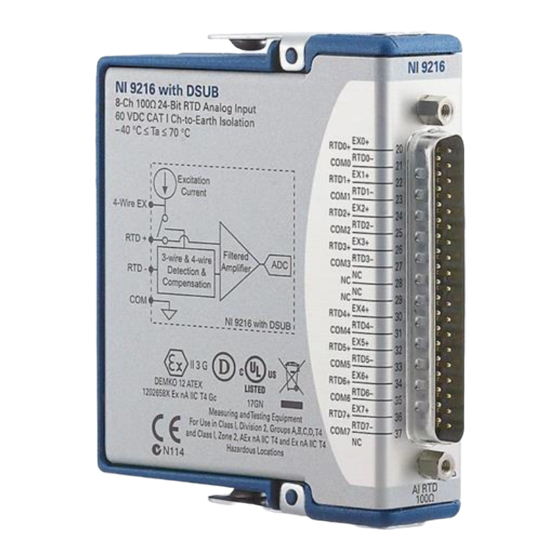Summary of Contents for National Instruments NI 9216
- Page 1 GETTING STARTED GUIDE NI 9216 8 RTD, 0 Ω to 400 Ω, 24 Bit, 400 S/s Aggregate, PT100...
-
Page 2: Safety Guidelines
This document explains how to connect to the NI 9216. In this document, the NI 9216 with spring terminal and the NI 9216 with DSUB are referred to inclusively as the NI 9216. Before you begin, complete the software and... -
Page 3: Safety Guidelines For Hazardous Voltages
NI 9216 with spring terminal. Do not connect hazardous voltages to the NI 9216 with DSUB. Ensure that hazardous voltage wiring is Caution performed only by qualified personnel adhering to local electrical standards. NI 9216 Getting Started Guide | © National Instruments | 3... -
Page 4: Safety Voltages
NI 9216 with Spring Terminal Isolation Voltages Channel-to-channel None Channel-to-earth ground Continuous 250 Vrms, Measurement Category II Withstand up to 3,000 Vrms, verified by a 5 s 5,000 m dielectric withstand test 4 | ni.com | NI 9216 Getting Started Guide... - Page 5 Withstand Up to 3,000 m 1,000 Vrms, verified by a 5 s dielectric withstand test Up to 5,000 m 860 Vrms, verified by a 5 s dielectric withstand test NI 9216 Getting Started Guide | © National Instruments | 5...
-
Page 6: Safety Guidelines For Hazardous Locations
CAT III, or CAT IV. Safety Guidelines for Hazardous Locations The NI 9216 is suitable for use in Class I, Division 2, Groups A, B, C, D, T4 hazardous locations; Class I, Zone 2, AEx nA IIC T4 and Ex nA IIC T4 hazardous locations; and nonhazardous locations only. - Page 7 II 3G and is suitable for use in Zone 2 hazardous locations, in ambient temperatures of -40 °C ≤ Ta ≤ 70 °C. If you are using the NI 9216 in Gas Group IIC NI 9216 Getting Started Guide | © National Instruments | 7...
-
Page 8: Electromagnetic Compatibility Guidelines
Electromagnetic Compatibility Guidelines This product was tested and complies with the regulatory requirements and limits for electromagnetic compatibility (EMC) stated in the product specifications. These requirements and 8 | ni.com | NI 9216 Getting Started Guide... - Page 9 To ensure the specified EMC performance of Caution the NI 9216 with DSUB, the length of all I/O cables must be no longer than 30 m (100 ft). NI 9216 Getting Started Guide | © National Instruments | 9...
-
Page 10: Special Conditions For Marine Applications
In addition, take precautions when designing, selecting, and installing measurement probes and cables to ensure that the desired EMC performance is attained. 10 | ni.com | NI 9216 Getting Started Guide... -
Page 11: Preparing The Environment
Preparing the Environment Ensure that the environment in which you are using the NI 9216 meets the following specifications. Operating temperature -40 °C to 70 °C (IEC 60068-2-1, IEC 60068-2-2) Operating humidity 10% RH to 90% RH, (IEC 60068-2-78) noncondensing... - Page 12 RTD5- RTD3- COM3 EX2+ EX6+ EX4+ RTD2+ RTD6+ RTD4+ RTD4- COM4 RTD2- RTD6- EX5+ RTD5+ RTD5- COM5 EX6+ EX3+ EX7+ RTD6+ RTD6- RTD3+ RTD7+ COM6 EX7+ RTD3- RTD7- RTD7+ RTD7- COM7 12 | ni.com | NI 9216 Getting Started Guide...
- Page 13 In 4-wire mode, the EX terminal is a 1 mA current source. In 3-wire mode, the RTD+ terminal is a 1 mA current source. The NI 9216 NI 9216 Getting Started Guide | © National Instruments | 13...
- Page 14 RTD+ RTD– NI 9216 For the best measurement results when using the NI 9216 with a 3-wire RTD, use equal-length wires between the RTD+ terminal and the RTD and between the COM terminal and the RTD. Also, keep the lead resistance within 5% of the nominal RTD value.
- Page 15 NI 9216 with spring terminal. • For the NI 9216 with spring terminal, push the wire into the terminal when using a solid wire or a stranded wire with a ferrule.
-
Page 16: High-Vibration Application Connections
High-Vibration Application Connections If your application is subject to high vibration, NI recommends that you use the NI 9940 backshell kit to protect connections to the NI 9216 with spring terminal. 16 | ni.com | NI 9216 Getting Started Guide... -
Page 17: Where To Go Next
NI 9216 Datasheet NI-RIO Help NI-DAQmx Help LabVIEW FPGA Help LabVIEW Help RELATED INFORMATION C Series Documentation Services ni.com/services & Resources ni.com/info cseriesdoc Located at ni.com/manuals Installs with the software NI 9216 Getting Started Guide | © National Instruments | 17... -
Page 18: Worldwide Support And Services
(EMC) and product safety. You can obtain the DoC for your product by visiting ni.com/certification. If your product supports calibration, you can obtain the calibration certificate for your product at ni.com/calibration. 18 | ni.com | NI 9216 Getting Started Guide... - Page 19 United States, visit the Worldwide Offices section of ni.com/niglobal to access the branch office websites, which provide up-to-date contact information, support phone numbers, email addresses, and current events. NI 9216 Getting Started Guide | © National Instruments | 19...
- Page 20 U.S. Government Customers: The data contained in this manual was developed at private expense and is subject to the applicable limited rights and restricted data rights as set forth in FAR 52.227-14, DFAR 252.227-7014, and DFAR 252.227-7015. © 2017 National Instruments. All rights reserved. 378022A-01 Jan17...










Need help?
Do you have a question about the NI 9216 and is the answer not in the manual?
Questions and answers